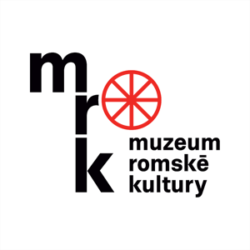Ignác Zima
Ignác Zima (born 1938 at Kopčany, Skalica district) started writing a chronicle of his life as a boy in the settlement, accompanied by his own illustrations and maps. He graduated from the municipal school and was then apprenticed as a roofer. At the age of eighteen he went to work for Czechoslovak Railways in Hodonín, and while working there he graduated first from industrial school and then from a school of social and legal studies. He worked at the railway for thirty-five years, twenty of which were spent in the head office. He then accepted an offer of employment with the Central Committee of the Gypsy-Roma Union in Brno, where he moved with his family in 1971. When the union was dissolved in 1973, he returned to work for the railways and stayed there until 1990, when he became head of the Brno Labour Office. In retirement, he taught Roma boys who wanted to become police officers, and at the age of 60 he began studying at the Faculty of Education of the Masaryk University in Brno. He collected Romani fairy tales and in the early 1990s was also at the birth of the Museum of Romani Culture in Brno. Among other things, he was a basket maker, and created theatre props, and many of his handicrafts, such as a model of a wagon, are in the collections of the Museum of Romani Culture. At the Drom Roma Cultural Centre in Brno, which was run by his son, he led a basketry club for Roma boys and girls. In 2015, he received the Museum of Romani Culture Award for his long-standing cooperation, his care for the preservation and development of the Romani language and other areas of traditional culture, and for passing on historical consciousness to future generations.
-
Testimony abstract
Zima's father fought in World War I. Originally a blacksmith, he later worked on a farm with horses. There were two other Romani blacksmiths at Kopčany, one was called Bata,[1] the other Korčák.[2] Ignác Zima's mother worked as a servant for farmers and received food in return. They had seven children, one daughter who died in her youth, and six sons. Twenty Roma families lived in the settlement at Kopčany, which was called héli. Before the outbreak of the war, Roma musicians from Kopčany used to go to Moravia to play at festivals. The Roma in Kopčany also wove baskets and brooms out of birch wicker, which the women then offered around the villages and received potatoes or beans in exchange. They also sold the farmers’ wives fine yellow sand, which they spread on the ground at feasts to make their homes more beautiful.
Some Roma from Moravia managed to escape from the Protectorate to Slovakia, so they were saved. Some of them, such as such as Kýr,[1] Franta[2] and Karel[3] from the Union of Roma [Union of Romani-Gypsy], were even hidden by Slovaka.
Ignác Zima's eldest brother was conscripted into the army and was captured in Russia, along with other Roma, such as Františka Zimová's brother Matěj. Local Roma partisans included Palko,[4] Ferda,[5] and also Izák.[6]
The guards treated the Roma terribly. In the winter, for example, they dragged them out of the house barefoot into the snow; they didn't even allow them to take their shoes.
The guardsmen were mainly men from rich farming families; only about two of them came from poor backgrounds.
At the time when Ignác Zima was hiding with his parents and siblings in the woods around “Smolnička”[7] and Šaštín, the Germans established an ammunition store in their house and placed an anti-aircraft gun right in front of the house. When the Zima family returned, Ignác’s father, an experienced soldier, decided that they would dig a two-metre-deep pit to which they carried the ammunition and buried it.
When the Russians arrived, the local Roma first saw it as a deliverance. But then they started to go after their women, and so even the older ones had to hide under the bed and smear themselves with soot to make themselves ugly.[8] The Germans had not been like that; Ignác Zima said they were probably too choosy to start anything with gypsy women. A Russian, called Misha rode his bicycle to the settlement and went after Lucko[9]’s girlfriend Kori, who was nicknamed “Slepá” (Blind)[10]. Her father heard screaming and crying from the house, so he ran in, threw Misha out, beat him and smashed his bicycle. The Russian had to leave on foot, and when his commander heard what had happened, he said he wanted to shoot him. But the Russians gave the Roma food, which the children came to fetch with pots. Ignác Zima recalled that he and the the other children wanted to try smoking, but to get cigarettes they had to do “quails” – lie on their backs and shake their arms and legs. He said the Russians stood round them laughing.
He also remembered that when the front moved closer and they were hiding in the farmer's cellar in the village, there were Hungarians in yellow uniforms with them. They were afraid of the Russians because Hungary had fought on the side of the Germans. However, Bučko[11]'s little girl, who was still wrapped in swaddling clothes, started crying a lot, so the Hungarians threw them out because they were afraid of being exposed. Then they hid in the stable, where Kalnáčka's boy[12] started to create a fuss. His father couldn't bear it anymore, so he took some slurry and water and gave it to him to drink; the boy apparently stopped crying and nothing at all happened to him.
- [1] First name not given.
- [2] Last name not given.
- [3] Karel Holomek, one of the most important Romani scholars and representatives of the ethno-emancipation movement before and after 1989.
- [4] Bartoloměj Daniel (ed.) also speaks of the partisan Palko from Kopčany; see the memoir in this database; Palko's surname is not given.
- [5] Surname not given.
- [6] Surname not given.
- [7] Probably the village of Smolinská.
- [8] See Koloman Pompa's testimony: when the soldiers of the Slovak army were returning from Italy through western Slovakia; people welcomed them as protectors against the Russians raping women. (ed.)
- [9] Not specified.
- [10] Not specified.
- [11] Not specified.
- [12] Not specified.
Everybody knew very well who in the village had been in the Hlinka Guard during the war, but nothing happened to any of them after the liberation.
Straight after the war, Ignác Zima's brother Jalka, a soldier, was deployed against the “Banderites”; they searched for them in the forests.
How to cite abstract
Abstract of testimony from: HÜBSCHMANNOVÁ, Milena, ed. “Po židoch cigáni." Svědectví Romů ze Slovenska 1939–1945.: I. díl (1939–srpen 1944). 1. Praha: Triáda, 2005. ISBN 80-86138-14-3, s. 610-622 (cs), 623-635 (rom). Testimonies of the Roma and Sinti. Project of the Prague Forum for Romani Histories, https://www.romatestimonies.com/testimony/ignac-zima (accessed 11/25/2025) -
Origin of Testimony
The interview with Ignác Zima took place in September 1999 at Kopčany at the home of his sister-in-law Františka Zimová,[1] where they had gone after hearing a story about a Roma girl from Oslavany, Moravia. Apparently she had survived the war in Kopčany and thus escaped transport to Auschwitz, where the majority of Roma from the Protectorate perished. It was her Romani friend and language advisor Ignác Zima who had mentioned this story to the editor, also referring her to his sister-in-law, who was ten years older, since he was only one year old at the beginning of the war. He then authorized the interview and, at the editor's request, added a few words about himself.
- [1] See her memoir in the database.
-
Where to find this testimony




